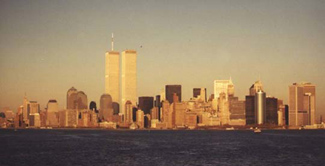MICHAEL R. H. SWANSON Ph. D
OFFICE: Feinstein College 110
Hours: M, T, th, F 9:00 -10:00
Or By Appointment
Phone: 254 3230
..no man is an island, entire of itself; every man is a piece of the continent, a part of the main.
If a clod be washed away by the sea, Europe is the less, as well as if a promontory were, as well as if a manor of thy friend's or of thine own were: any man's death diminishes me, for I am involved in mankind, and therefore never send to know for whom the bell tolls; it tolls for thee.
John Donne (1572-1631)
The Manhattan Skyline with the World Board of Trade Buildings, destroyed in a terrorist attack on September 11, 2001





